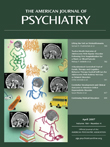Dr. McGrath Replies on Behalf of the STAR*D Trial Team
To the Editor: Drs. Wingo and Ghaemi raise two methodological points regarding our article describing the results from Level 4 treatment in the STAR*D. The first point is that adjusting for previous medication intolerance, which differed between the tranylcypromine and venlafaxine/mirtazapine groups, would be important to estimate comparative effects of the treatments. We agree, and in fact did adjust for this in the analyses we presented, as is noted in footnote b to Table 3.
The second point suggests that we downplayed a numerical difference in the response rate between the two treatments that was not statistically significant, essentially endorsing a lack of difference in treatments possibly because of a type II error. Drs. Wingo and Ghaemi are correct that our primary endpoint of remission had limited power to detect small effect sizes. However, we chose to emphasize the primary endpoint of remission because it was specified a priori, which limits the possibility of chance findings to the specified significance rate, which is not the case if multiple outcome measures are analyzed separately. They assert that the nonsignificant difference on the secondary measure of response is “most consistent with a high probability of an effect.” We disagree—the probability of an effect in this data is clearly not “high” because the probability is most correctly described by the probability of a type I error, that is, the p value. Whether a larger study might find these numerical differences to be significantly different remains speculative.
We believe that Drs. Wingo and Ghaemi neglect another more likely explanation of any putative difference between treatments, which is that poorer tolerability of tranylcypromine in this study resulted in shorter durations of treatment and less chance to show improvement. However, even accepting their interpretation of the response rates leads to the same conclusion stated in our article, perhaps with the addition noted in brackets: “The lower side effect burden, lack of dietary restrictions, [numerical though not significant advantage in response rate], and ease of use of venlafaxine and mirtazapine suggest that this combination may be preferred over tranylcypromine for patients with highly-resistant depression who have not benefited adequately from several prior treatments.”



